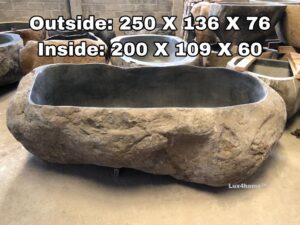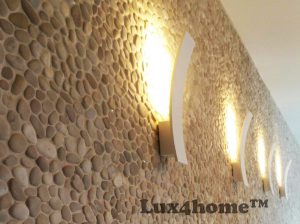5 amazing stone bathtubs designs you should see in 2020-2023 5...
Read MoreIs a Stone Bathtub...?
We’ve gathered the most common questions from customers interested in purchasing a natural stone bathtub. They might prove useful to you as well.
Table of Contents
General customer questions:
Are natural stone bathtubs good?
Stone bathtubs have long been associated with luxury. They offer a unique sense of visual aesthetics, and bathing in such a tub becomes a special relaxation experience for the body. The body positively responds to the naturalness of the stone. Bathtubs made from various mixtures, resins, concretes, terrazzo, or artificial materials are not classified as natural stone bathtubs and should not be labeled as such.
What are the benefits of stone bath?
Some believe that baths in a natural stone tub are beneficial for hypertension, joint pains, and skin allergies. However, it is certain that natural stone has a highly relaxing and soothing effect on both the body and mind, with no harmful side effects. This is why it is widely utilized in every SPA.
Are stone baths better than acrylic?
Definitely. The main differences are: the stone used for the tub is harder, more pleasant to the touch, and is a 100% natural product. Additionally, natural stone absorbs and retains heat from the water several times better than acrylic, which does not. This means you can spend more time in the bath without the need to add warmer water. A stone bath provides a much greater sense of relaxation and comfort compared to acrylic.
What are the pros and cons of natural stone bathtub?
Natural Stone Bathtubs Versus Stone Resin Bathtubs: Pros and Cons
Pros: Easier to maintain than an acrylic or stone resin bathtub. Retains water heat longer than any other type of tub. Longest lifespan. Provides a greater sense of relaxation. Each stone is unique and therefore each tub is unique.
Cons: Heavy. Prior to installation, ensure your floor can support the weight and size of the tub. More expensive than acrylic or synthetic material tubs.
What are stone baths made of?
We produce natural stone bathtubs using river stone, onyx, marble (available in Indonesia), petrified wood, and andesite. Our bathtubs are carved from a single block of stone, without any gluing, filling of gaps, or joining multiple pieces. We manufacture the bathtub from a single piece of natural rock. Any other tubs made from composite mixed materials such as resins, adhesives, mortars, concretes, or acrylics cannot be qualified as being made of stone.

Is a stone bathtub a good investment for the value of my home?
Everyone who has purchased a natural stone bathtub so far claims it is. A stone bathtub is so durable and unique that, like any stone, it is resistant to changing design trends. In the bathroom, many things may change countless times, but the stone bathtub and sink will remain the same for years. It’s a good investment. All historic buildings prove that, despite the passage of years, stone remains forever.
What distinguishes a stone bathtub from other materials in terms of durability?
- Certainly, it’s 100% natural composition. For instance, some acrylic tubs may yellow over the years, while stone remains the same.
- Scratch resistance (except for marble tubs), river stone tubs are extremely hard and resilient to many external factors.
- River stone tubs can be used outdoors.
Are different types of stone used to build bathtubs and how do they differ from each other?
In Indonesia, natural stone bathtubs are crafted from river stone (the hardest), marble, onyx, andesite, and petrified wood. The toughest and most resilient to damage are river stone and andesite. Tubs made from these stones can be used both indoors and outdoors, as we’ve discussed previously. Marble and onyx tubs are more demanding as these stones aren’t as hard as granite or andesite, and cannot be used outdoors. Petrified wood tubs are unique; it’s a rare material, making these tubs quite expensive.
How does the cost of a stone bathtub compare to other materials?
Comparing the cost of a natural stone bathtub to, for instance, an acrylic one can be challenging. Natural stone bathtubs tend to be more expensive, and the final price depends on the size and type of stone used. However, it all depends on how you look at it. When considering that acrylic tubs have a shorter lifespan and may need replacement over the years, while a stone bathtub remains a permanent fixture, the investment becomes more apparent. Additionally, there are the added benefits of relaxation and overall well-being.
Moreover, there are conglomerate or acrylic tubs from companies or brands that have a similar price range to our stone bathtubs. To determine the cost of a stone bathtub, please get in touch with us and provide more details. We need information on the type of stone, the size, and the timeframe you’d like to have the bathtub. All these factors influence the price.




